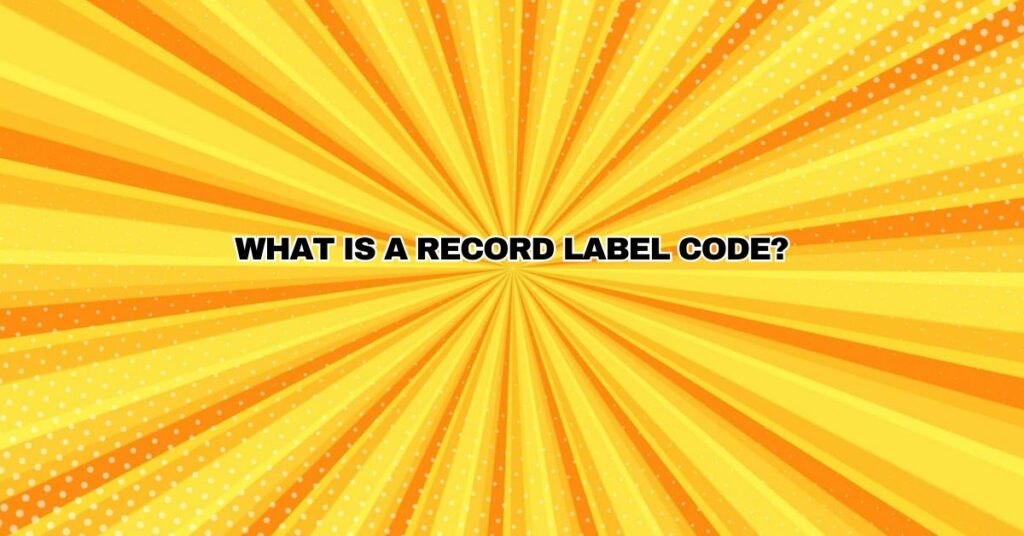If you’ve ever taken a closer look at the packaging of a music CD or vinyl record, you may have noticed a series of numbers and letters often referred to as the “record label code” or “label catalog number.” These codes serve a vital role in the music industry, and they hold valuable information regarding the specific release of an album or single. In this article, we will explore what record label codes are, their significance, and how to decipher them.
What Is a Record Label Code?
A record label code, also known as a catalog number or catalog identifier, is a unique alphanumeric code assigned by a record label to each of its music releases. These codes are typically found on the spine, back cover, or label of CDs, vinyl records, and other physical formats. They play a crucial role in the identification, organization, and tracking of music releases in the industry.
Components of a Record Label Code:
A typical record label code consists of several components, each with a specific meaning:
- Label Name or Abbreviation: The first part of the code often includes the record label’s name or a shortened version (an abbreviation or label logo). This is a quick way to identify the record label responsible for the release.
- Catalog Number: Following the label name or abbreviation, the primary component of the code is the catalog number itself. This unique identifier is specific to the particular release and helps music distributors, retailers, and collectors distinguish one release from another.
- Additional Information: In some cases, a record label code may include additional information, such as format (CD, vinyl, digital), country of origin, or the release year. These details can further clarify the release’s specifications.
Significance of Record Label Codes:
Record label codes serve several important purposes in the music industry:
- Identification: These codes are crucial for identifying and cataloging music releases, making it easier for music distributors, retailers, and collectors to manage their inventory and sales.
- Tracking: Record label codes are used to track sales, distribution, and royalties for artists and copyright holders. They help record labels monitor the performance of their releases in the market.
- Organization: The codes assist in organizing a label’s entire discography. This is particularly important for large record labels with extensive catalogs, making it easier to manage and promote their artists’ work.
- Copyright Management: Record label codes are an essential part of copyright management. They allow rights organizations to track the use and distribution of music to ensure that artists and copyright holders receive their due royalties.
Deciphering Record Label Codes:
Deciphering record label codes is relatively straightforward once you understand their structure. Here’s a simplified breakdown of a typical record label code:
- Label Name or Abbreviation: This part identifies the record label behind the release. It can be the full label name or an abbreviation or logo specific to that label.
- Catalog Number: The catalog number is a unique identifier assigned by the record label to distinguish the release from others in their catalog. It helps retailers and consumers order the correct release.
- Additional Information: Some record label codes include format, country of origin, or release year. These details provide additional context for the release.
Using Record Label Codes:
For collectors and enthusiasts, record label codes are invaluable for identifying and tracking specific releases, especially when it comes to limited editions, reissues, and variations of albums or singles. These codes help you ensure that you’re getting the exact version of a release you’re seeking.
To use record label codes effectively:
- Cataloging: Maintain a record of the catalog numbers for your collection. This will help you keep track of what you own and what you’re still looking for.
- Research: Online databases, music forums, and reference books can help you decode and understand the record label codes for various releases. This information can be especially useful for collectors looking for specific pressings or editions of albums.
- Authentication: When buying records or CDs online or from secondhand stores, the catalog number can help you authenticate the release and ensure it’s the genuine version you’re seeking.
In conclusion, record label codes are a fundamental component of the music industry, providing a means of identification, tracking, organization, and copyright management for music releases. For collectors and music enthusiasts, understanding and using these codes can greatly enhance the experience of collecting and enjoying music in physical formats like CDs and vinyl records. They allow you to identify and authenticate releases with precision and detail.

